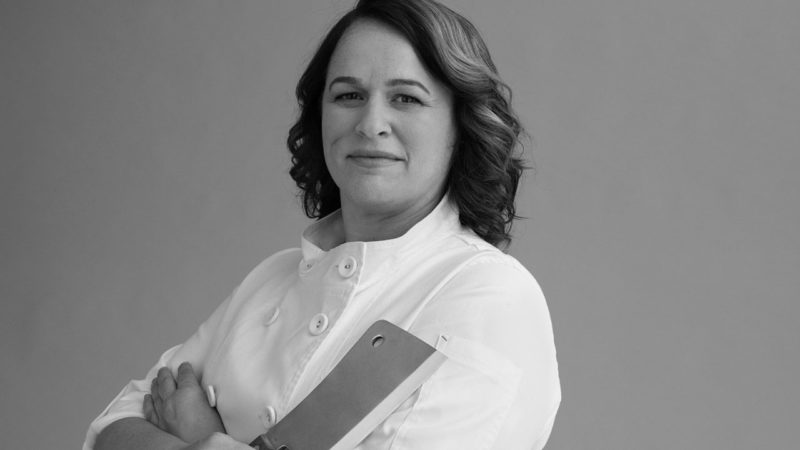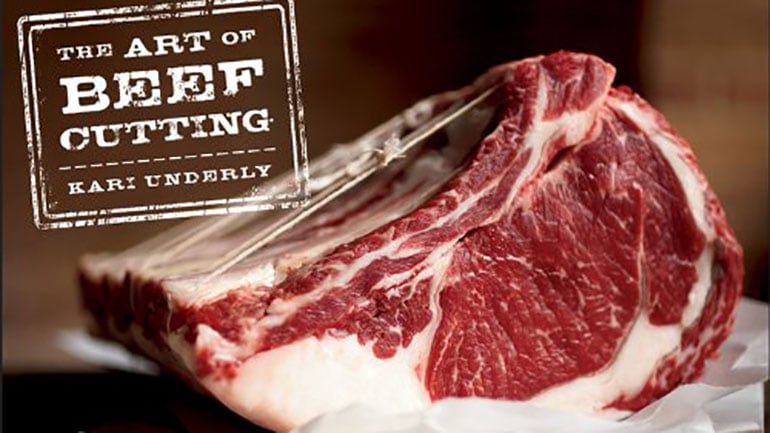Last Updated on March 1, 2022
Kari Underly is a powerhouse in the meat industry. A third-generation butcher, she has taught people all over the country how to cut, market, and sell meat. Her book The Art of Beef Cutting (2011, John Wiley & Sons), was nominated for a James Beard Award and IACP Award. She founded Range® in Chicago in 2002 and launched Range Meat Academy Online in 2018.
Recently, I had the opportunity to interview Kari. Below is my conversation with her about her incredible career.
Tell me about your path to the meat industry. What inspired you to become a butcher and to eventually teach?
I was first introduced to the trade through my family. My grandparents and my Dad were all butchers. I apprenticed for three years, and then I became a meat cutter. I got myself through college cutting meat. I knew I didn’t want to work in a slaughterhouse or a grocery store, though.
When I founded Range (formerly known as “Home on the Range”), I developed cut chart posters, new cuts of meat, training aids, collateral, and photography. I realized people wanted more information, and that pushed me to write The Art of Beef Cutting.
People wanted to train with me, and I traveled all over the country, but that life wasn’t sustainable. About 10 years ago, I was diagnosed with MS. Though I wanted to build a brick and mortar butchery school, I decided to film all the training content and put it online, just in case something happened with my illness.
We launched the online school last year and currently have 150 online members. Veterans are trying to join and get the education approved via the GI Bill, and we’re talking to major grocery stores to partner with them in getting their butchers trained. Range is now approved by the Illinois Board of Higher Education to be a vocational school, and we want to become a brick-and-mortar school eventually.
Hands-on training in the meat industry is so important because butchers need to develop their muscle memory.
The physical side of the job is getting harder for me—my left leg is weak and my hands get weak…weakness and fatigue are part of the illness. I hope to bring in other great experts in the industry to help me teach.
What are some of the obstacles women face when entering the meat industry?
The meat industry is tough to get into, especially in terms of pay. Being a woman in the meat industry is still difficult—prejudice still exists that women can’t handle the job and the banter in the meat room. Just because I’m a woman doesn’t mean I can’t do the labor. Most managers are male, and it’s difficult for a woman to move up.
Women bring a slightly different approach to the meat industry. They understand that meat needs to be more about cooking, cutting, and curing. Women have more of the guts to buy their own shops and start their own businesses and work with chefs. But there’s a lack of capital and funding for start-ups. Women are still considered a minority, and they’re not paid as well. I personally have been skipped over—people have refused my help sometimes simply because I’m a woman.
What do you value most when purchasing meat? What qualities must the meat have?
There are so many different types of meat, but I tell people to buy the best food they can afford. One time I went to Publican in Chicago and bought two pork chops for $45, and my Dad practically passed out when I told him that.
I would love to have local, pasture-raised meat all the time, but unfortunately, our industry has changed that business model. Customers want transparency in where animals come from and how they’re raised. Farms are overseen by meat inspection, but we don’t have enough grasslands in the US to have all cattle on grass.
Any important tips for how to handle meat?
Make sure that your cutting board doesn’t move on the countertop. Quickly anchor your cutting board by putting a wet paper towel underneath the cutting board, then push the cutting board into the counter a little bit so that it doesn’t slip.
Also, put your meat in the freezer to chill for a little so that it isn’t as loose—this way you’ll end up with cleaner slices. Take your time, don’t freak out. Start with easier cuts of meat like a pork loin…you can’t mess up a pork loin.
We also need to rethink the amount of meat we consume. We’ve gotten used to buying and eating a 16oz steak, but you can get thin strips for hot pot or stir-fries. We don’t need that much protein: 4 oz is a serving.
How can women in the meat industry connect with one another?
Meat Business Women is an international group active in the UK, Ireland, Australia, and New Zealand. Their US chapter will meet for the first time this year.
Kristina DeMichele is the Digital Content Strategist at Harvard Magazine. She is also a freelance copyeditor who has worked for America's Test Kitchen as the Senior Content Editor of Cook's Illustrated Magazine.




